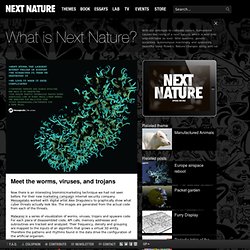

Main.dvi.
Computer Science. Singularity-Emergence A.I. The Singularity is not coming - Cognitive Social Web - A better web, for a better world. OpenCog. Last updated: Sep 28, 2012 OpenCog is an open-source software project to build a human-level artificial general intelligence (AGI).

The name "OpenCog" is derived from "open", meaning open source, and "cog", meaning cognition. OpenCog doesn't emulate the human brain in any detail. Instead it uses currently available computer hardware to run software that draws inspiration from neuroscience, cognitive psychology, and computer science. The assumption is that the human brain is only one particular way of achieving general intelligence and that other methods are just as viable.
Latest news News to follow... General introduction Info to follow... Cognitive architecture Central to OpenCog is a neural/semantic memory system called the AtomSpace. Working on this knowledge base are a number of algorithms, or cognitive processes, which are called MindAgents. A core principle of OpenCog is that there is no single algorithm that is responsible for intelligence.
AtomSpace Knowledge representation MindAgents. Outline of artificial intelligence. The following outline is provided as an overview of and topical guide to artificial intelligence: Artificial intelligence (AI) – branch of computer science that deals with intelligent behavior, learning, and adaptation in machines. Research in AI is concerned with producing machines to automate tasks requiring intelligent behavior. Branches of artificial intelligence[edit] Some applications of artificial intelligence[edit] Philosophy of artificial intelligence[edit] Mind Children: The Future of Robot and Human Intelligence - Hans Moravec - Google Books. Internet Traffic is now 51% Non-Human. So you thought the Internet was made by and for people?

Think again. A study by Incapsula, a provider of cloud-based security for web sites (mind you where this data comes from), concludes that 51% of all Internet traffic is generated by non-human sources such as hacking software, scrapers and automated spam mechanisms. While 20% of the 51% non-human traffic is’ good’, the 31% majority of this non-human traffic is potentially malicious. The study is based on data collected from 1,000 websites that utilize Incapsula’s services, and it determined that just 49% of Web traffic is human browsing. 20% is benign non-human search engine traffic, but 31% of all Internet traffic is tied to malicious activities. 19% is from ” ‘spies’ collecting competitive intelligence,” 5% is from automated hacking tools seeking out vulnerabilities, 5% is from scrapers and 2% is from content spammers.
Presumably these numbers will only rise. Meet the worms, viruses, and trojans. Now there is an interesting biomimicmarketing technique we had not seen before.

For their new marketing campaign internet security company Messagelabs worked with digital artist Alex Dragulescu to graphically show what cyber threats actually look like. The images are generated from the actual code from each of the threats. Malwarez is a series of visualization of worms, viruses, trojans and spyware code. For each piece of disassembled code, API calls, memory addresses and subroutines are tracked and analyzed.
Their frequency, density and grouping are mapped to the inputs of an algorithm that grows a virtual 3D entity. Augmented Bodies. Humans have long augmented our bodies with eyeglasses, clothing, and prosthetics.

Thanks to recent scientific advancements, we are now on the cusp of a second wave of body-modification. Nanotechnology may give us contact lens cameras and robots small enough to patrol our bloodstreams. Genetic modification could tweak us to be smarter, smaller and more eco-friendly, while neural interfaces might allow us to plug our brains directly into the web. Nature made us. Next Nature made us better. Swallowable Perfume Lucy McRae's speculative, digestible capsule of perfume gives perspiration a delightful scent. The Next Hacking Frontier: Your Brain In the past year, researchers have developed technology that makes it possible to use thoughts to operate a computer, maneuver a wheelchair or even use Twitter — all without lifting a finger. Read more Should We Use Eugenics to Avoid Climate Change?
Read more Conducive Bodypaint Incredibly Shrinking Humanity Read more.